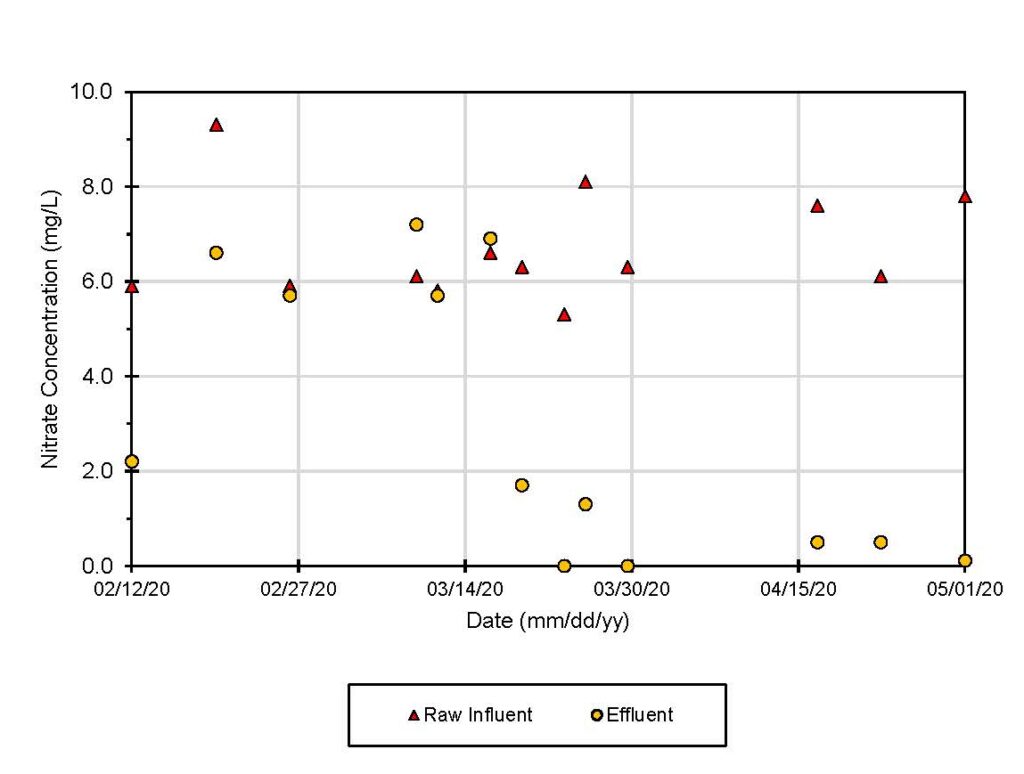Many groundwater sources in the United States have elevated levels of nitrate, which can lead to public drinking water suppliers exceeding the Environmental Protection Agency’s (EPA) Maximum Contaminant Level (MCL) limit of 10 mg/L. Regularly consuming water with nitrate concentrations above the MCL can reduce the oxygen-carrying capacity of the blood; resulting in shortness of breath and possibly fatality in humans. Conventional approaches to treating nitrate include ion exchange or reverse osmosis, both which are effective but generate large quantities of brine salts leading to multiple environmental concerns.
WSB has successfully removed nitrate from the groundwater without generating harmful residuals using biological filtration. Biological filtration removes nitrate through denitrification. Denitrification is the process by which nitrate is removed from the source water by converting it to non-toxic nitrogen gas (78 percent of the air we breathe is comprised of nitrogen). Biological filtration employs conventional filters to clean the source water. However, the filters are populated with naturally occurring microbes that enable the biological conversion of nitrate. Both the Minnesota Department of Health (MDH) and the EPA consider biological denitrification to be an efficient and effective method for treating nitrate in public drinking water supplies, additionally, it significantly reduces the amount of chemicals used and generate significantly fewer residuals. An external carbon source may need to be dosed to promote microbial growth in the filters depending on the type of water to be treated (groundwater or surface water).
Although biological denitrification has been used in wastewater treatment for decades, it has only been effectively used in the United Stated for drinking water treatment in recent years. Therefore, MDH requires a pilot study to be completed prior to implementing this treatment process full-scale. WSB recently completed a biological filtration pilot study for the City of Hastings, Minnesota. Hastings’ water supply is provided by groundwater wells that are open to the Jordan Sandstone Aquifer. The Jordan Aquifer is a shallow and, sometimes vulnerable, aquifer that commonly produces groundwater with significant levels of nitrate. Hasting’s wells produce water nitrate concentrations that range from 6 to 9 mg/L. The city currently has an existing ion exchange water treatment plant that removes the majority of the nitrate before it enters the distribution system. The figure above shows the nitrate removal results obtained during the pilot study. The average influent nitrate concentration during the 12-week pilot study was 6.7 mg/L. WSB’s biological filtration pilot plant consistently reduced the influent nitrate concentrations in Hastings’ well water to below 1.0 mg/L. Several samples had non-detectable levels of nitrate which demonstrated the pilot plant’s capability to remove all nitrate from the City’s raw water. Nitrate removal did not occur immediately as the microbes required a couple of weeks to populate the filters in order to denitrify the water. These microbes are not harmful to humans as they are inactivated using disinfection prior to pumping the water to the distribution system. Nitrite is formed as an intermediary step between nitrate and nitrogen gas. Nitrite causes similar health effects than nitrate, but it is more toxic as its MCL is only 1.0 mg/L. Effluent nitrite concentrations were maintained at zero or near zero during the pilot study.
If your community’s source water has elevated nitrate levels, WSB’s water treatment engineers can work with you to develop a comprehensive pilot protocol, collaborate with state agencies, and conduct a pilot study using WSB’s pilot plant to help you determine if biological filtration can treat most or all of the nitrate in your raw water without generating harmful residuals. For more information, please contact WSB.


